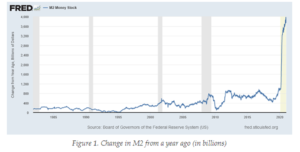
Elaine Garzarelli, the economist behind Garzarelli Capital, has provided a compelling analysis showing that the Trump administration’s policies were the main driver of the inflation surge seen in 2021. According to her firm, the significant rise in the money supply during Trump’s final year in office was the direct cause of inflationary pressures that followed, as demonstrated in the firm’s charts.
GARZARELLI CAPITAL: “.. the rise in money supply .. during Trump’s last year in office .. led to rising inflation showing up about a year later.
“.. Biden’s stimulus packages contributed to the decline in the inflation rate because his
programs produced strong gains in… pic.twitter.com/mZtpkWqsLK— Carl Quintanilla (@carlquintanilla) August 23, 2024
Trump’s Influence on the Fed’s Monetary Policy
During the COVID-19 pandemic, Trump demanded that the Federal Reserve take aggressive actions to boost the economy, threatening to fire Fed Chairman Jerome Powell if he didn’t comply (The New York Times). Trump’s pressure on the Fed culminated in a flood of liquidity into the market, causing the M2 money supply to increase by over 25% (Federal Reserve Economic Data). This sharp expansion in the money supply set the stage for inflation.
Stay up-to-date with the latest news!
Subscribe and start recieving our daily emails.
The American Institute for Economic Research shows us the data from the FED website HERE:
Figure 1 shows the 12-month changes in the M2 since 1982. In 2020, M2 increased by almost $4 trillion, by far the largest expansion in US history.

The chart comes through blurry due to some technical issue; however – it’s clear to see 2020 and the yellow box on the right of the chart as having a rapid increase.
In 2016 – while running for President his first time Trump told CNN:
This is the United States government. First of all, you never have to default because you print the money. I hate to tell you. So there’s never a default.
In addition to pressuring the Federal Reserve, Trump once floated the idea of printing money to reduce the national debt. According to Bob Woodward’s book, Fear: Trump in the White House, Trump suggested, “Just run the presses—print money,” as a solution to the growing debt burden (CNBC). This reckless approach demonstrates Trump’s willingness to use extreme measures in monetary policy, which, if enacted, could have exacerbated inflationary pressures in the economy.
Milton Friedman, in his iconic statement, declared that “Only government can create inflation,” explaining that mismanagement of monetary policy is the root cause of inflationary problems. Friedman’s wisdom remains relevant today, and you can hear it directly from him:
The Economic Effects of Trump’s Policies
By early 2021, inflation—as measured by the Consumer Price Index (CPI)—rose sharply. Garzarelli’s analysis shows a dramatic increase in inflation, reaching over 8%, and the accompanying Personal Consumption Expenditures (PCE) deflator surged similarly. The excessive growth of money in circulation, prompted by Trump, directly correlated with these inflationary pressures.
Not wrong.
(via Garzarelli Capital) pic.twitter.com/Fb2ZWuq5XJ
— Carl Quintanilla (@carlquintanilla) June 14, 2024
However, Trump’s actions weren’t without positive effects. The Fed’s expansionary monetary policies helped the economy recover from losing one million jobs a month during the pandemic (Bureau of Labor Statistics) and unemployment reached historically low levels in 2022 under Biden. The rapid liquidity injection may have contributed to inflation, but it also spurred a quick rebound in the job market.
Historical Context: Political Pressure on Central Banks
Trump’s pressure on the Fed to increase the money supply is reminiscent of Richard Nixon’s influence on the Federal Reserve in the 1970s, where he pushed for loose monetary policies that led to the Great Inflation (Brookings Institution). In more extreme cases, countries like Argentina have experienced rampant inflation due to political interference in central bank operations (The Economist). These historical parallels demonstrate the dangers of political leaders pushing central banks toward unsustainable policies.
Biden’s Response: Reversing Course
As the Garzarelli Capital charts demonstrate, the Biden administration successfully curbed inflation. His policies, including the Infrastructure Investment and Jobs Act and the Inflation Reduction Act, contributed to productivity gains, which helped reduce inflation. Garzarelli’s analysis highlights how inflation has now dropped to below 3%, and unit labor costs have decreased, indicating a stabilization of the economy.
GARZARELLI CAPITAL: Today’s disinflation is “a mirror image of what happened after WWII .. there was a pause in inflation’s downtrend .. lasted for several months, and then .. resumed .. we are experiencing a similar pause and see inflation following a similar path downward ..” pic.twitter.com/91JeErOXFA
— Ron wright (@ronsterd89) April 20, 2024
Once inflation hit due to Trump’s monetary policies, it became clear that simply controlling it under Biden wouldn’t mean prices would return to their previous levels. Even though Biden’s administration took measures to slow inflation, prices remained elevated. Inflation is often stubborn, meaning Biden’s focus has been on preventing further price acceleration rather than undoing the damage caused by Trump’s policies. The challenge Biden faced was stabilizing the economy without triggering another surge in inflation, as bringing prices back down to pre-Trump levels was never realistic.
In conclusion, Garzarelli’s firm correctly attributes the inflation surge to the Trump administration’s monetary policies. While the Federal Reserve’s aggressive actions under Trump helped recover the job market, the accompanying inflation was an inevitable consequence of overexpansion. As Biden’s policies focused on long-term productivity gains, the economy has begun to stabilize, offering a valuable lesson in balancing growth with inflation control.
Featured Image via X
